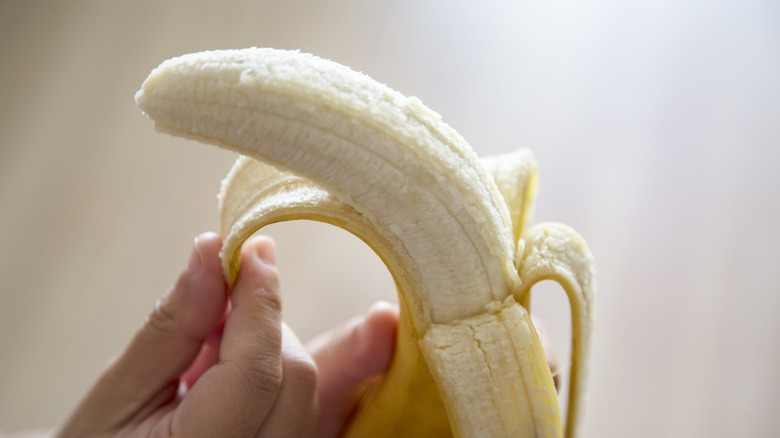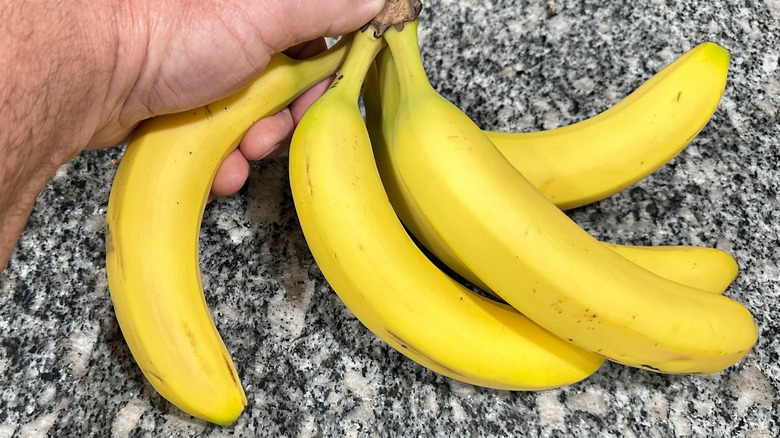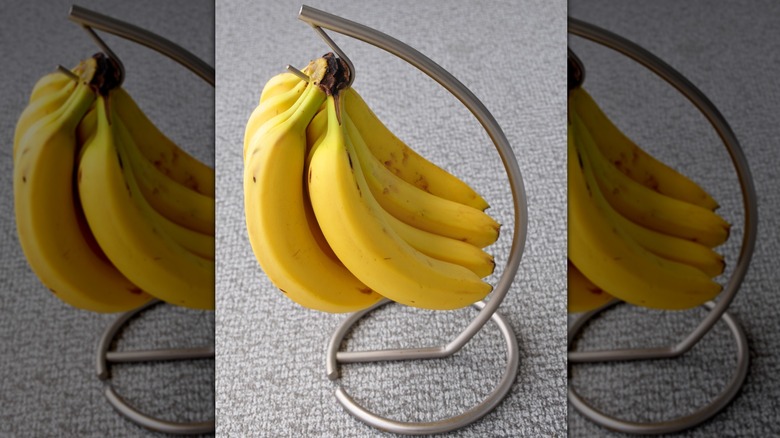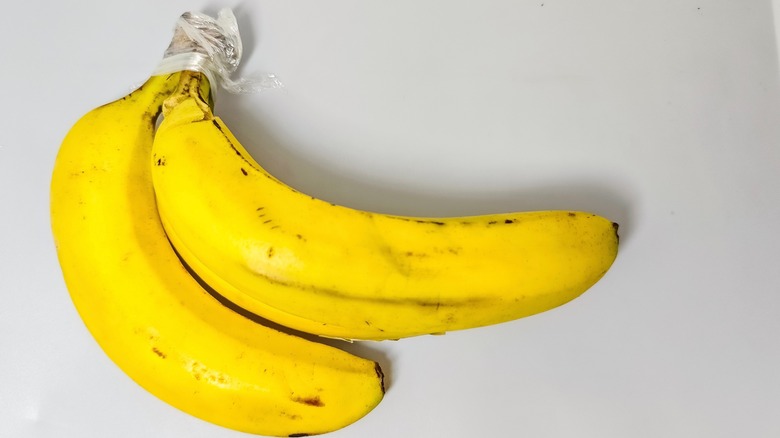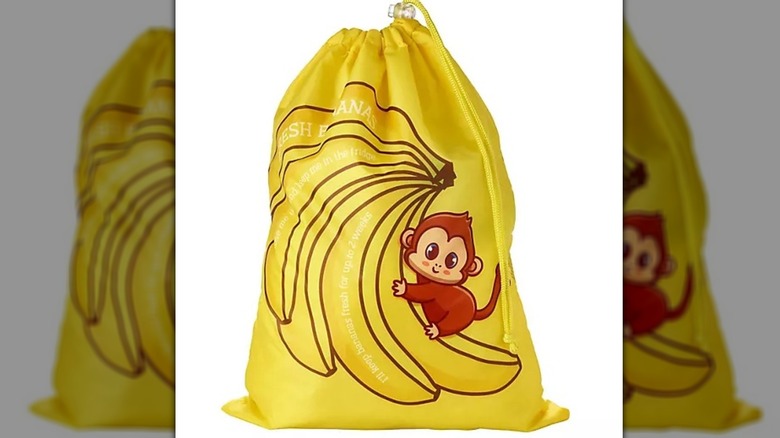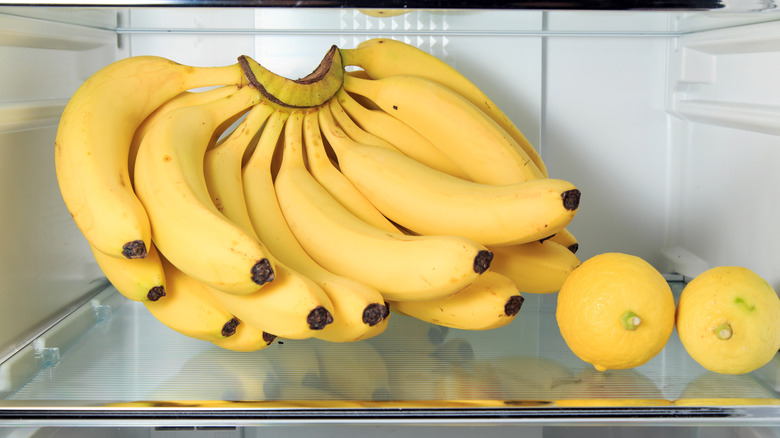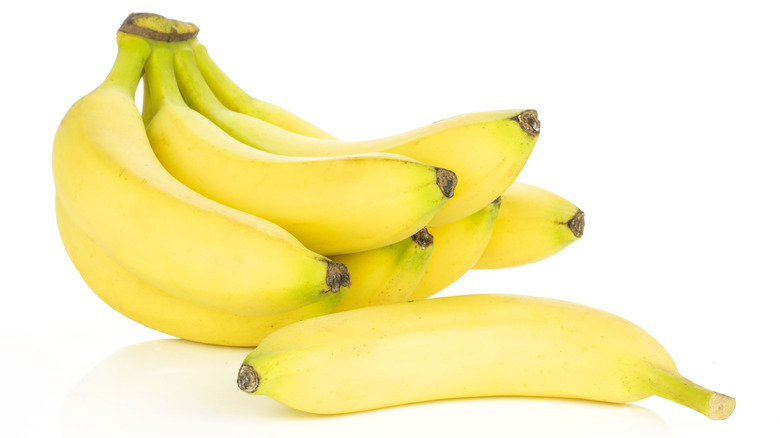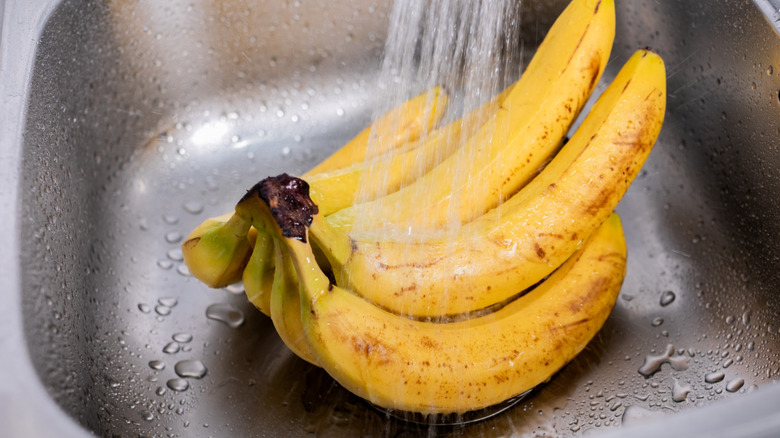10 Easy Ways To Keep Bananas Fresh For Longer
We may receive a commission on purchases made from links.
They're a fixture in millions of fruit bowls around the world and in the United States, and part of a $25 billion-dollar global market. But what makes the banana so popular? Is it their sweet taste, their health benefits (including being packed with potassium), or that they're always affordable? One or more of those reasons will be behind a shopper's decision to pick up a bunch, little realizing their purchase is a reflection of consumer spending habits.
Many people may also be unaware that just about every banana they buy is the same kind: Cavendish, despite there being more than 1,000 varieties of the fruit. In the 1950s, preferred type Gros Michel was all-but wiped out by a soil fungus, while a similar threat faces the Cavendish variety. For the moment at least, we can carry on chowing down on this popular fruit, and while some prefer them slightly green and under-ripe, others want their bananas vibrant yellow and at peak sweetness.
Imported bananas spend time in special ripening facilities so they are ready for us to enjoy when we get home. Popping them in a 300 F oven for up to half an hour will also ripen them — but what if we're not ready to eat our favorite fruit straight away? Here are easy ways to keep your bananas fresh for longer.
Keep them on your countertop
An apple a day may keep the doctor away but nothing beats peeling a banana and biting into that unmistakably sweet fruit. They go down well with kids and adults, and are a delicious part of many desserts, from puddings to salads. Keeping bananas fresh, however, can be a job in itself. One minute they're beautifully yellow and smooth, the next they're gross, brown and the insides are mush. But there is a way to extend their shelf life.
Start by buying them while they're still far from ripe. Then, when you bring them home, leave them to ripen over several days (depending on how green they are) by leaving them on the countertop. Now, here's where things get a bit science-y. Bananas ripen faster the warmer their environment, and the recommended ambient temperature for them is between 54 degrees Fahrenheit and 70 degrees Fahrenheit.
So, if your kitchen is in a sunny spot or the heating's always on, it's worth finding a cooler corner that's out of direct sunlight to keep them. That includes keeping your bananas away from the stove or oven, as the radiated heat can also speed up ripening. If you have the countertop space, make sure you move them regularly, to prevent them being bruised by the hard surface.
Pop them in the fridge
Every day it seems as though we're given advice on what foods we should be keeping in our fridge and what really needs to be stored elsewhere. Whether you just throw everything in and cross your fingers, or are super-organized when it comes to the fridge drawer, it is a good place to put your bananas if you want to keep them fresh for longer. But don't be tempted to do it right away.
Bananas are a tropical fruit and thrive in warmer climates (though Icelandic growers are trying to buck that trend). If you prefer to buy your bananas while they're still green and allow them to ripen at home, storing them in the fridge could prevent them from ripening at all. The best thing to do is give them a few days to turn completely yellow at room temperature then slip the whole bunch in the fridge.
The colder conditions will put the brakes on the enzymes that help bananas to ripen so you can enjoy them for longer. However, it's worth noting that other chemical activity will continue in the fruit, turning the peel a not-so appetizing brown or black color. Don't be put off: As long as the fridge isn't extra cold or the banana hasn't been kept in it for too long, it should be perfectly delicious.
Store them in the freezer
Bananas are available all year round but our kitchen space isn't, even with this nifty trick to increase storage space. Luckily, freezing bananas is a great way to preserve them so they're on hand whenever you want a sweet, fruity boost. Even better, there are multiple ways to do it, but no matter which you plump for, it's important that your bananas are ripe to begin with.
If you decide to freeze them whole, it's up to you whether you leave the skin on or remove it, though what might swing the decision is peeling a frozen banana can be tricky. You can also peel them and either cut them in half or in slices to freeze them, but make sure they don't stick together in a clump by laying them on a parchment paper-lined sheet pan before putting them in the freezer. After a couple of hours, take them out and pop your frozen banana halves or slices in a plastic bag.
Be sure to write the date on it, and when you come to use them, don't throw away any liquid that's accumulated in the bag — it's packed with intense banana flavor and a great ingredient for baking. Mashed bananas also freeze brilliantly. Just have at them with a fork or blender until they're smooth, then spoon into individual containers or ice cube trays. When they're fully frozen, put them into a plastic bag but remove as much air as possible before sealing.
Use a banana hanger
Our kitchens are full of gadgets that are designed to make our lives easier and simpler. Whether it's using this fancy bit of kit to make oils and syrups or a cake pop storage secret weapon, there's something for every home cook to love. Keeping our bananas fresh hasn't been excluded from the party, either, but don't worry if you're not a fan of electrical gizmos, it's very much a low tech solution.
The banana hanger is your BFF if you want to keep your favorite fruit in tip-top condition, but maybe not for the reason you might think. Using a hanger doesn't slow down natural ripening, but it does elevate the fruit. Keeping them away from hard surfaces minimizes the risk of your bananas bruising, which can speed up ripening as the amount of ethylene — the gas that drives the process — it produces increases.
As with storing your bananas on the countertop, make sure to hang them out of direct sunlight and well away from sources of heat. Best of all, there are lots of designs out there, so there's bound to be plenty that fit your kitchen aesthetic. Go funky like this one with a giraffe, choose a sleek, contemporary style hanger, or opt for one that can be fixed to the underside of your kitchen cabinet. Whichever kind you choose, you'll always have delicious, ripe bananas.
Wrap the ends in foil or plastic
More than six billion pounds of bananas are bought every year in the United States alone, and some of them are sold complete with a way to keep them fresher for longer. If you've ever wondered what the plastic, tightly wrapped around the top of the stem where the banana "fingers" are joined, is for, here's the skinny: It's to slow down the ripening process.
Bananas are among several fruits and vegetables that emit ethylene gas which at best encourages, at worst accelerates, the ripening process. It's why you should avoid keeping your onions and potatoes together. In bananas, much of the ethylene comes from the stem, so plugging it can help prevent the fruit from spoiling too fast. There are several ways you can do this.
One of the easiest is to cover the very ends of your banana stems in either plastic wrap or tinfoil. Both work equally well, just be sure to wrap them tightly to leave no gaps. If you'd rather have a natural material touching your fruit, beeswax wraps, like these plastic and silicone-free ones, are ideal and they're reusable too. Not every up-and-coming business that appears on "Shark Tank" makes it, but the firm behind these cute knitted hats for bananas looks like they're doing fine.
Seal them in an airtight container
When it comes to keeping bananas fresh, there are a lot of home cooks who are firmly on the side of Team Freezer. While that works in the mid to long term, it's not great for the here and now, while anyone who's navigated the confines of a small fridge with a bunch of bananas inside knows keeping whole fruit in there can be a pain too. There is a solution, though it's a controversial one.
Using an airtight container can be a good way to store fresh bananas, especially ones that have been peeled and/or sliced. Put them in a box with a good, tight-fitting lid and they'll keep in your fridge for up to four days. One social media user suggested wrapping whole bananas in paper towels before putting them in box and the whole lot in the fridge. They warned the peel would turn dark and make a popping sound when cut but the banana inside would be perfectly edible.
Others vehemently oppose bananas being stored like this, warning it can actually speed up the rotting process as moisture becomes trapped inside the box. If you just want to keep your banana fresh (and in one piece) during the morning commute, a camping trip or ahead of school lunch, why not try a hard-case carrier, which comes in three colors?
Invest in a banana bag
There is a hack for everything these days. Want an easier way to slice meat, sick of peeling potatoes or need somewhere for your coffee mug collection? Done, done, and done. So it's no surprise that creative minds have looked at the problem of how to keep bananas fresh and come up with an answer for that too: the banana bag.
We're not talking fried versions of the fruit (which will be good for up to two months in a baggie), the thin plastic bags you find at the grocery store, or even the colorful mesh nets that oranges and other produce are sold in. Banana bags like this are specifically designed to help keep the tropical fruit fresh in the fridge for up to a fortnight. The bags are also insulated and big enough to hold several fruits at a time.
Your bananas stay at just the right temperature, there's no chill damage if you run your fridge a little colder, and that all-important air flow is maintained so the skins stay nice and yellow. Some people insist the flavor can be more intense in fruit stored this way. Just pop the bananas inside, pull the drawstring closed, and voila: fresh, tasty fruit when you want it.
Spritz them with citrus juice
Lemons are, hands down, a kitchen workhorse. They're a delicious flavoring for lots of sweet and savory recipes, lemon juice can "cook" fish and clean your house, while leftover lemons are great for butterflies. Just when you think this versatile citrus fruit has emptied its bag of tricks, turns out it's also great for helping to keep fruit, including bananas, fresh as a daisy.
Cut apples or peaches can turn brown very quickly, thanks to the chemical reaction between enzymes in the fruit and the oxygen in the air. Lemon juice prevents that reaction, so your apples and peaches stay a nice, appetizing color. It's the same for bananas, but the key is how much of the citrus you use.
The two flavors don't naturally go together (though it could be a delicious addition to this quick and easy banana bread recipe) but a light spritz of lemon juice over some sliced bananas won't affect the fruit's sweet taste. Dipping them in pineapple or orange juice will also do the trick, as will brushing on a little honey, thinned with water to create a sort of glaze.
To separate or not to separate?
Of all the ways that we can deploy to keep bananas fresh for longer, none generate as much conversation as whether they should be separated or not. While everyone agrees that bananas (either in a large bunch or individually) need to be isolated from other ethylene-producing fruits and vegetables, there are some who say that keeping several bananas together will also prevent them from ripening too quickly.
But there are others who insist that separating the fruit will have the same effect, especially in bunches where one or two bananas may be more ripe than the others. You could even split several bananas and put them in multiple places around your home, such as on the kitchen counter or in a living room fruit bowl, so they will all ripen at different times.
Fundamentally, this method of preserving bananas comes down to personal choice, but it's worth noting that separating the fruit can be useful if you have a small or partial bunch and want to make them last a little longer. No matter which you prefer, make sure to always wrap the stems.
Wash your bananas
Billions of dollars' worth of bananas are imported into the United States every year, from countries including Guatemala, Costa Rica, and Thailand. Commercial bananas are harvested before they are fully ripe, so there is time to transport them before they hit their peak. Some are sent to ripening rooms, where ethylene gas, or other agents, such as acetylene gas, ethephon, and lauryl alcohol are used to bring the fruit to its peak.
Some consumers feel these chemicals need to be washed off their bananas before they eat them, while others believe a dip in salty water can slow down the ripening process. Not everyone thinks this is necessary to keep bananas fresh, but it is a great way to eliminate any bacteria that may have built up on the skins. The fruit in your kitchen has likely come a long way picking up all sorts of microscopic nasties. Cleaning your bananas can prevent any of them from getting to the fruit inside, particularly if the skins are a little damaged or bruised.
There's no need to reach for the soap or scrubbing brush. The USDA recommends simply dousing fresh bananas in cool, running water, a simple step that can also help prevent fruit flies from targeting your kitchen looking for a free feast.
